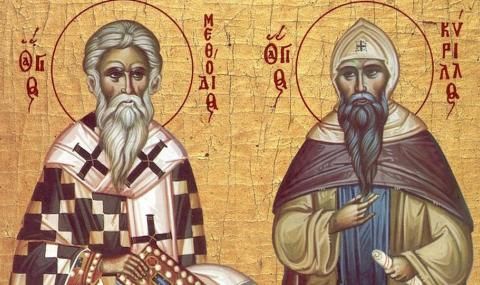Today is May 24 - Day of Bulgarian Enlightenment, Culture and Slavic Writing. The national holiday is celebrated every year on May 24, commemorating the creation of the Glagolitic script by the brothers Cyril and Methodius, also known as the Thessalonica brothers.
According to the church calendar, the Day of St. St. Cyril and Methodius, who created the prototype - Glagolitic - of the Bulgarian script, which is also a Slavic script, is celebrated on May 11.
The Glagolitic alphabet underwent peculiar changes until it took shape in its current form - Cyrillic, in which Bulgarian, Russian, Ukrainian, Macedonian, Serbian and other languages are written. The Cyrillic alphabet is the official alphabet in Mongolia and in some republics of the former Soviet Union, and until the 19th century it was also used in Romania.
In 1851, for the first time in Plovdiv, St. St. Cyril and Methodius. The day later began to be celebrated as the Day of Bulgarian Enlightenment and Culture and of Slavic Writing. In 1975, the monument to the Holy Brothers Cyril and Methodius was opened in front of the National Library in Sofia.
Cyrillic, which is used by nearly 11 countries as the official alphabet and is a simplified version of Glagolitic.
The Glagolitic alphabet was created by St. St. Cyril and Methodius during the First Bulgarian State in the 9th century.
It is believed that Glagolitic was simplified by St. Kliment Ohridski, who named the new Cyrillic variant.
In the original version of the Cyrillic alphabet, compiled by St. Kliment Ohridski, there are 44 letters for the 44 sounds, unlike the current Bulgarian alphabet with 30 letters.
Glagolitic and, therefore, Cyrillic borrowed an alphabet system from Egyptian hieroglyphs, the Proto-Sinai writing system, and the Greek alphabet. The system of writing and structuring words is a combination of the Latin, Coptic, Armenian, Gregorian and Verbal alphabets.
The earliest inscription written in Cyrillic is from 931 in a cave monastery near the village of Krepcha in Bulgaria. The earliest manuscripts written in Cyrillic are the “Book of Sheba”, dated between the 10th and 11th centuries.
The word “alphabet” arises from the pronunciation of the first two letters of the Glagolitic alphabet – “A” and “B”. The Latin word “alphabet” was constructed in the same way. (English alphabet) from the Greek letters alpha and beta, first in the Greek alphabet.
Cyrillic is also used as a script by non-Slavic languages such as Kazakh, Mongolian, Ossetian, Tatar, Tajik and in some parts of Alaska.
The Cyrillic alphabet was modified and simplified many times until it reached its current form. The original Cyrillic alphabet was used only in Old Church Slavonic – the language in which church literature was written in Russia and part of Eastern Europe.
Cyrillic is the third official alphabet of the European Union. The first, different from the Latin alphabet, is the Greek alphabet.
Each letter in the Cyrillic alphabet had its own name, which meant something. For example, A - “I” (I), B – “bucks” (letters), In – “lead” (I know), G – “verbs” (words, speak), D – “good” (goodness, goodness) etc. The names of the letters helped the students to remember the alphabet and order
more easily
